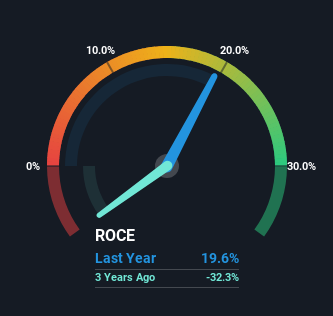- Japan
- /
- Food and Staples Retail
- /
- TSE:2708
We Like Kuze's (TSE:2708) Returns And Here's How They're Trending
To find a multi-bagger stock, what are the underlying trends we should look for in a business? Ideally, a business will show two trends; firstly a growing return on capital employed (ROCE) and secondly, an increasing amount of capital employed. Put simply, these types of businesses are compounding machines, meaning they are continually reinvesting their earnings at ever-higher rates of return. With that in mind, the ROCE of Kuze (TSE:2708) looks great, so lets see what the trend can tell us.
Understanding Return On Capital Employed (ROCE)
Just to clarify if you're unsure, ROCE is a metric for evaluating how much pre-tax income (in percentage terms) a company earns on the capital invested in its business. To calculate this metric for Kuze, this is the formula:
Return on Capital Employed = Earnings Before Interest and Tax (EBIT) ÷ (Total Assets - Current Liabilities)
0.20 = JP¥2.1b ÷ (JP¥27b - JP¥17b) (Based on the trailing twelve months to December 2023).
Thus, Kuze has an ROCE of 20%. In absolute terms that's a great return and it's even better than the Consumer Retailing industry average of 8.8%.
Check out our latest analysis for Kuze

While the past is not representative of the future, it can be helpful to know how a company has performed historically, which is why we have this chart above. If you're interested in investigating Kuze's past further, check out this free graph covering Kuze's past earnings, revenue and cash flow.
What Can We Tell From Kuze's ROCE Trend?
We like the trends that we're seeing from Kuze. The data shows that returns on capital have increased substantially over the last five years to 20%. Basically the business is earning more per dollar of capital invested and in addition to that, 34% more capital is being employed now too. So we're very much inspired by what we're seeing at Kuze thanks to its ability to profitably reinvest capital.
On a separate but related note, it's important to know that Kuze has a current liabilities to total assets ratio of 61%, which we'd consider pretty high. This effectively means that suppliers (or short-term creditors) are funding a large portion of the business, so just be aware that this can introduce some elements of risk. While it's not necessarily a bad thing, it can be beneficial if this ratio is lower.
In Conclusion...
To sum it up, Kuze has proven it can reinvest in the business and generate higher returns on that capital employed, which is terrific. And a remarkable 148% total return over the last five years tells us that investors are expecting more good things to come in the future. In light of that, we think it's worth looking further into this stock because if Kuze can keep these trends up, it could have a bright future ahead.
One final note, you should learn about the 2 warning signs we've spotted with Kuze (including 1 which is significant) .
Kuze is not the only stock earning high returns. If you'd like to see more, check out our free list of companies earning high returns on equity with solid fundamentals.
Valuation is complex, but we're here to simplify it.
Discover if Kuze might be undervalued or overvalued with our detailed analysis, featuring fair value estimates, potential risks, dividends, insider trades, and its financial condition.
Access Free AnalysisHave feedback on this article? Concerned about the content? Get in touch with us directly. Alternatively, email editorial-team (at) simplywallst.com.
This article by Simply Wall St is general in nature. We provide commentary based on historical data and analyst forecasts only using an unbiased methodology and our articles are not intended to be financial advice. It does not constitute a recommendation to buy or sell any stock, and does not take account of your objectives, or your financial situation. We aim to bring you long-term focused analysis driven by fundamental data. Note that our analysis may not factor in the latest price-sensitive company announcements or qualitative material. Simply Wall St has no position in any stocks mentioned.
About TSE:2708
Kuze
Engages in the food wholesale business for food service industries in Japan and internationally.
Flawless balance sheet average dividend payer.
Market Insights
Community Narratives




